
Jacques d'Arthois stands as a significant figure in the rich tapestry of 17th-century Flemish art. A prominent painter of the Baroque era, he dedicated his career primarily to the genre of landscape painting, capturing the natural beauty of his native region with remarkable skill and sensitivity. Born in Brussels in 1613 and passing away in the same city in 1686, d'Arthois spent his entire life immersed in the artistic environment of the Southern Netherlands, contributing significantly to the development and popularity of landscape art during his time.
His works are celebrated for their detailed depiction of the countryside surrounding Brussels, often featuring dense forests, rolling hills, winding rivers, and the characteristic sandy soil of the area. D'Arthois possessed a unique ability to convey the serene and poetic qualities of nature, establishing himself as a leading landscape specialist within the vibrant Brussels school of painting. His legacy endures through his numerous canvases, which continue to be admired in museums and collections worldwide.
Early Life and Artistic Formation
Jacques d'Arthois was born into the bustling artistic center of Brussels in 1613. His artistic education took place within the established traditions of the Flemish School. According to available records, he began his formal training as an apprentice under the painter Jan Mertens on January 11, 1625. This foundational period would have exposed him to the techniques and stylistic conventions prevalent among Flemish artists of the time.
Further evidence suggests a strong connection, possibly that of a student, to Lucas van Uden, another noted Flemish landscape painter. While the precise nature of this relationship requires careful consideration of historical sources, Van Uden's influence, alongside that of other masters, likely played a role in shaping d'Arthois's developing style. His training grounded him firmly in the technical skills necessary for detailed representation and complex compositions.
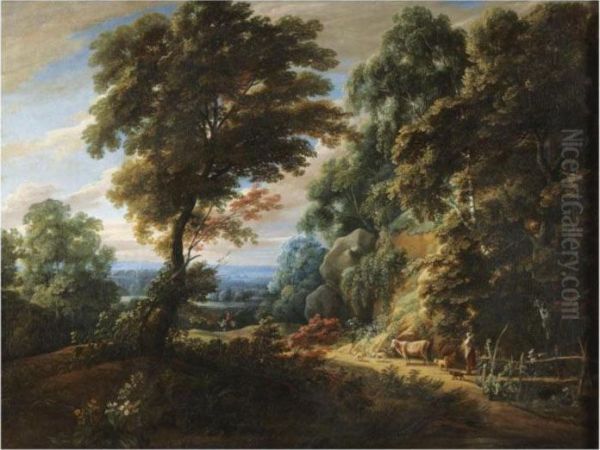
His talent and dedication led him to become a member of the prestigious Guild of Saint Luke in Brussels around 1634. Membership in the guild was a crucial step for professional artists, signifying their official recognition and granting them the right to establish their own workshop and take on apprentices. D'Arthois not only joined the guild but eventually rose to the position of Master, indicating his esteemed status among his peers and his commitment to the artistic community of Brussels.
Artistic Style and Techniques
Jacques d'Arthois developed a distinctive style rooted in the Baroque tradition but infused with his personal observation of nature. His primary focus was the landscape around Brussels, particularly the Sonian Forest (Zoniënwoud), whose majestic trees and undulating terrain appear frequently in his work. He rendered these scenes with meticulous attention to detail, capturing the specific textures of moss-covered tree trunks, the sandy quality of the soil, and the gentle flow of rivers and streams.
His approach to composition often involved creating expansive vistas, drawing the viewer's eye into the depth of the scene. He frequently employed compositional devices common in Baroque landscape painting, such as framing the view with prominent trees in the foreground or using winding paths and rivers to lead the eye towards the distant horizon. While grounded in the observation of local scenery, his compositions often possess an idealized quality, balancing naturalism with a sense of order and harmony.
The influence of Italian landscape painting, possibly absorbed through prints or the work of contemporaries who had traveled south, is evident in d'Arthois's handling of light and shadow. He skillfully used chiaroscuro to create dramatic effects, contrasting brightly lit clearings or skies with the deep shadows of the forest. This manipulation of light not only added volume and depth to his scenes but also contributed to their emotional atmosphere, which could range from tranquil and idyllic to somber and evocative.
Although primarily a landscape painter, d'Arthois often incorporated figures into his scenes. These figures, sometimes painted by collaborators, typically depict peasants, travelers, hunters, or mythological and religious characters. Their scale is usually small relative to the grandeur of the landscape, emphasizing the dominance of nature. This integration of figures adds narrative interest and helps to animate the scenes, situating human activity within the vastness of the natural world.
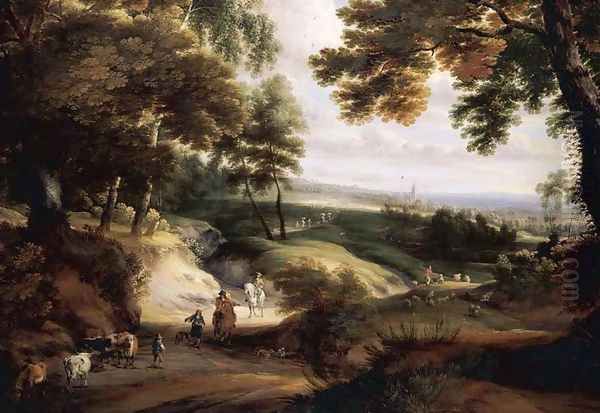
His technique involved precise brushwork, particularly in the rendering of foliage, bark, and terrain. He built up his paintings with layers of paint, achieving rich textures and subtle tonal variations. The overall effect is one of both realism in detail and a powerful, often atmospheric, representation of the Flemish countryside. His style, while distinctly Baroque, sometimes hints at a near-Romantic sensibility in its emotional depth and appreciation for the untamed aspects of nature, or a Rococo pastoral charm in its idealized depictions of rural life under warm light.
Sources note that d'Arthois achieved a high degree of technical precision in his compositions. The use of rivers as a foreground element, a common practice among his contemporaries in artistic centers like Paris and Rome, appears in his work as well. Interestingly, while his art reflects stylistic trends found in these major European capitals, evidence suggests he may not have personally visited either Paris or Rome, instead absorbing these influences through other means within his Brussels context.
Key Themes and Subjects
The predominant theme in Jacques d'Arthois's oeuvre is the forest landscape. He excelled at depicting dense woodlands, often focusing on the interplay of light filtering through the canopy and the intricate textures of the forest floor. His forests are rarely empty; they are often populated with figures that add context or narrative, ranging from everyday rural activities to specific religious or mythological stories set within the natural environment.
Religious themes appear integrated into his landscapes. Works such as Large Forest Landscape with St. Francis Borgia and Forest Landscape with St. Stanislaus Kostka place these saints within expansive, detailed natural settings. Similarly, Extensive Landscape with a Monk Praying uses the vastness of nature to underscore the spiritual contemplation of the figure. These paintings served devotional purposes, often commissioned for churches or private chapels, blending piety with an appreciation for the beauty of creation.
Mythological subjects also feature in his work, as seen in Diana and her Nymphs in a Forest. Here, the classical figures are seamlessly integrated into a typically Flemish woodland setting, demonstrating d'Arthois's ability to adapt traditional themes to his landscape specialty. The natural environment remains the dominant element, providing a lush and atmospheric backdrop for the narrative.
Scenes of rural life and activities are common. Paintings like Forest Landscape with Villagers Celebrating, Sportsman with Hounds in a Field, and Forest Landscape with a Boar Hunt capture aspects of 17th-century life within the countryside. These works often convey an idealized vision of rural existence, emphasizing harmony between humanity and nature, a characteristic that aligns with the pastoral traditions popular during the period.
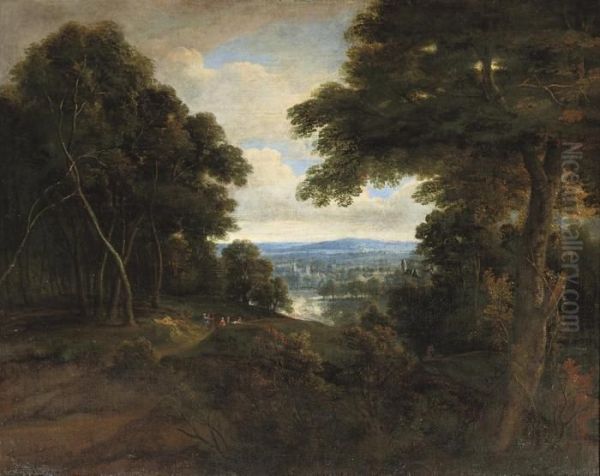
Pure landscapes, focusing solely on the natural elements of trees, water, hills, and sky, also form a significant part of his output. Works like Edge of the Wood, Wooded Landscape, and Rocky Landscape with Stormy Sky showcase his mastery in capturing different moods and atmospheric conditions. These paintings highlight his skill in rendering the specific topography and flora of the Brussels region, celebrating the inherent beauty of the local environment.
Representative Works
Jacques d'Arthois's prolific output includes numerous paintings that exemplify his style and thematic concerns. Among his most representative works are:
Large Forest Landscape with St. Francis Borgia and Forest Landscape with St. Stanislaus Kostka: These paintings are prime examples of his integration of religious figures into detailed woodland settings. The saints are depicted in moments of devotion or contemplation, dwarfed by the towering trees and expansive natural environment, emphasizing themes of spirituality within nature.
Edge of the Wood: This title likely refers to works focusing on the transition zone between dense forest and open land, a recurring motif for d'Arthois. Such scenes allowed him to explore contrasts of light and shadow and depict the intricate details of foliage and undergrowth.
Extensive Landscape with Travellers on a Path: This work showcases his ability to create deep, panoramic views. The inclusion of travellers adds a human element and sense of journey through the vast natural world, a common theme in Baroque landscape painting.
Forest Landscape with a Boar Hunt and Sportsman with Hounds in a Field: These paintings represent his engagement with genre scenes related to rural life and aristocratic pursuits. The dynamic action of the hunt is set against a meticulously rendered forest or field backdrop.
Diana and her Nymphs in a Forest: An example of his mythological landscapes, this work demonstrates his skill in combining classical narrative with his characteristic Flemish forest setting.
The Two Cottages on the Hill: This title refers to an etching created in collaboration with the renowned printmaker Wenceslaus Hollar, showcasing d'Arthois's involvement in printmaking projects alongside his painting career.
Landscape with a Waterfall: Mentioned in records associated with the Goss heirs, this work points to his depiction of varied natural features, including moving water, which allowed for dynamic compositions and the study of light on water surfaces.
This selection highlights the range of d'Arthois's work, from religious and mythological scenes integrated into landscapes to pure nature studies and depictions of rural activities, all characterized by his detailed observation and Baroque sensibility.
Collaborations and Contemporaries
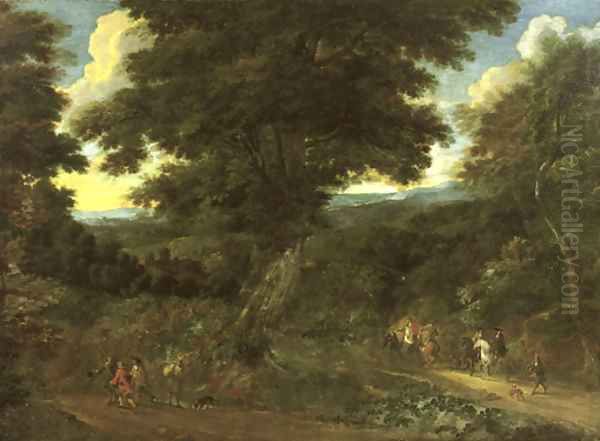
The artistic environment of 17th-century Brussels was highly collaborative, and Jacques d'Arthois actively participated in this culture. It was common practice for landscape specialists like d'Arthois to collaborate with figure painters to complete a single artwork. The landscape painter would create the setting, while another artist would add the human or animal figures.
Records indicate several such collaborations. D'Arthois is known to have worked with David Teniers the Younger, a highly versatile and famous Flemish painter known for his genre scenes. Teniers likely painted the figures in some of d'Arthois's landscapes, bringing his lively characterizations to d'Arthois's natural settings.
Another documented collaborator was Willem van Herp (often referred to simply as Van Herp), a Flemish genre and history painter. Van Herp provided figures for d'Arthois's background decorations and landscape compositions, combining their respective strengths. Similarly, d'Arthois collaborated with Dirck van Delen, a Dutch painter specializing in architectural perspectives, likely adding landscape backgrounds to Van Delen's architectural scenes or vice versa.
His collaboration extended to printmaking as well. The etching The Two Cottages on the Hill was made with Wenceslaus Hollar, a prolific Bohemian etcher who worked across Europe. This collaboration indicates d'Arthois's engagement with different artistic media and his connections beyond the immediate Brussels circle.
D'Arthois's work shows the undeniable influence of the towering figure of Flemish Baroque painting, Peter Paul Rubens. Rubens's own dynamic and richly coloured landscapes set a precedent that d'Arthois and others followed, adapting Rubens's vigorous style to their own observations. The influence of Anthony van Dyck, another giant of the Flemish Baroque primarily known for portraiture but also skilled in other genres, can also be discerned, particularly in the overall Baroque sensibility.
He was also connected to other landscape painters. As mentioned, he may have studied with or been influenced by Lucas van Uden. He is also considered a follower or part of the circle influenced by artists like Jan Wildens and Jan Joris van Hemskerck, who were significant landscape painters in their own right.
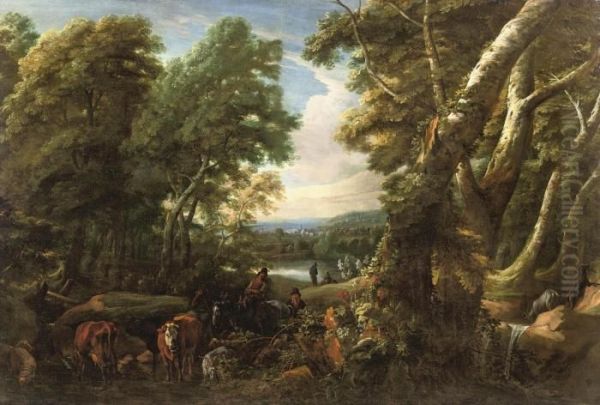
Furthermore, d'Arthois interacted with a broader network of Flemish artists, including figures like G. De Cuyper, Theobald Michau, Hendrik de Clerck (De H. Clerck), and Gilles Coques (G. Coquys). These interactions involved mutual influence in terms of style and technique, reflecting the close-knit nature of the Brussels art scene. His teacher, Jan Mertens, provided his initial training within this vibrant context. These connections place d'Arthois firmly within the mainstream of Flemish Baroque art.
Influence and Legacy
Jacques d'Arthois was a highly respected and successful artist during his lifetime, recognized as one of the foremost landscape painters in Brussels. His workshop was productive, and he trained several pupils, ensuring the continuation of his style and techniques. His position as a Master in the Guild of Saint Luke further cemented his status within the artistic community.
His influence extended beyond his direct pupils. His detailed yet atmospheric depictions of the Flemish countryside resonated with both Flemish and Dutch artists who followed him. He contributed significantly to the elevation of landscape painting as an independent and respected genre, moving it beyond its earlier role as mere background for historical or religious scenes. His focus on local scenery also encouraged other artists to explore the particularities of their own environments.
D'Arthois's paintings were sought after for various purposes. Many were commissioned to decorate churches and religious institutions, where his majestic forest scenes provided suitable settings for devotional contemplation. His works also found favour among private collectors who appreciated his technical skill and the evocative beauty of his landscapes. The enduring appeal of his work is evidenced by its continued presence in major museum collections across Europe, including Brussels, Vienna, and London.
His popularity continued after his death. Records show that his paintings fetched good prices at auctions throughout the 18th century, indicating a sustained appreciation for his art among collectors long after the Baroque era had passed. This lasting market value underscores his significance and the high regard in which his landscapes were held.
Today, Jacques d'Arthois is remembered as a key figure in the development of Flemish Baroque landscape painting. His ability to combine detailed naturalism with dramatic Baroque compositions and atmospheric effects created a powerful and enduring vision of the landscapes of the Southern Netherlands. He successfully captured both the specific character of the Brussels environs and a universal sense of nature's grandeur and poetry.
Art Historical Context and Noteworthy Aspects
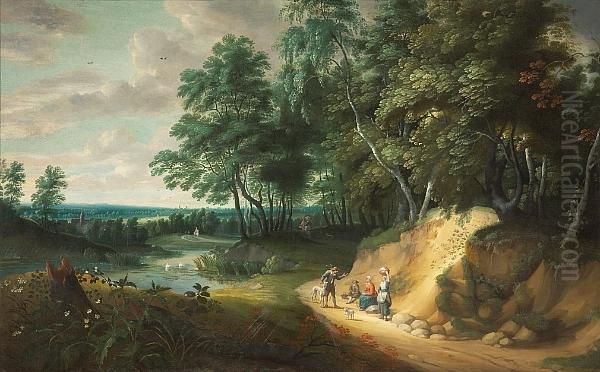
Jacques d'Arthois operated within the flourishing period of the Flemish Baroque, an era dominated by masters like Rubens and Van Dyck but also rich with specialized painters excelling in genres like landscape, still life, and genre scenes. D'Arthois carved out his niche as a leading landscape specialist in Brussels, distinct from the Antwerp school though clearly influenced by its major figures.
His work represents a continuation of the Flemish landscape tradition established by earlier artists like Pieter Bruegel the Elder and Gillis van Coninxloo, but updated with the dynamism, scale, and dramatic lighting characteristic of the Baroque. He balanced the Northern European tradition of detailed naturalism with influences from Italian landscape painting, creating a synthesis that was both regionally specific and internationally resonant.
An interesting aspect noted in the available sources is the apparent lack of significant controversy or unusual anecdotes surrounding his life and career. Unlike some artists whose lives were marked by dramatic events or disputes, d'Arthois appears to have pursued his profession with diligence and achieved considerable success and respect without notable incident. The records focus primarily on his artistic output, his training, his guild activities, and his collaborations.
This suggests a career characterized by steady production and professional integration within the Brussels art world. His contribution lies firmly in the quality and influence of his extensive body of work, which solidified the importance of landscape painting within the Flemish Baroque tradition and left a lasting legacy for subsequent generations of artists.
Conclusion
Jacques d'Arthois remains a pivotal figure in the history of Flemish art, celebrated for his mastery of Baroque landscape painting. Over a long and productive career based entirely in his native Brussels, he developed a distinctive style characterized by detailed observation of nature, dramatic use of light and shadow, and expansive, atmospheric compositions. His depictions of the forests and countryside around Brussels are both topographically specific and poetically evocative.
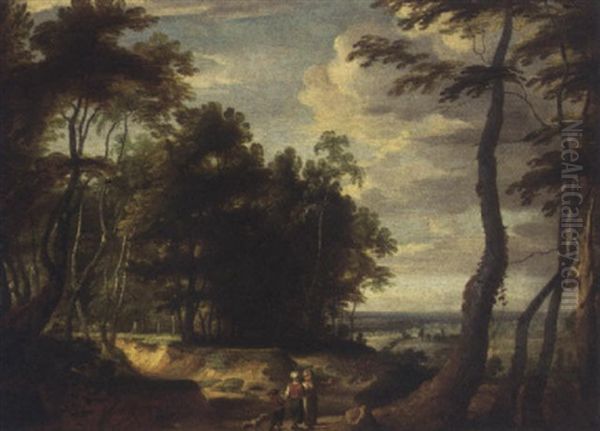
Through his numerous paintings, collaborations with prominent contemporaries like Teniers and Hollar, and influence on later artists, d'Arthois significantly contributed to the development and prestige of landscape painting as an independent genre. His works, found in churches, museums, and collections across the world, continue to testify to his skill in capturing the grandeur and intimacy of the natural world through the lens of the Baroque aesthetic. He stands as a testament to the depth and specialization within the Flemish art scene of the 17th century, a master whose dedication to landscape left an indelible mark on the history of European art.